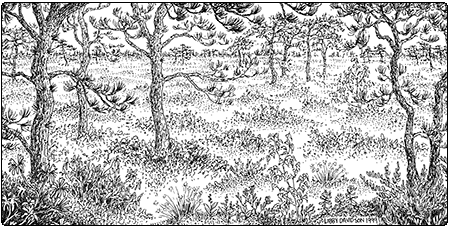Ecology and Physical Setting 
Only two examples of this community are known in Vermont. One, located within Colchester Bog, is very small. The other example, at Maquam Bog, is large and fascinating—it is unlike any other wetland in Vermont. Maquam Bog is an 890-acre open peatland located near the mouth of the Missisquoi River, with a mix of Pitch Pine Woodland Bog and Dwarf Shrub Bog. Pitch pine occurs in groves that are scattered in a ring around the open peatland surface. This peatland has a slightly raised center and a surface of irregular hummocks and hollows. Peat depths vary from 2.5 feet to nearly 8 feet. The peat is generally fibrous and woody at the surface, and it grades to muck at the base. The peatland water is acidic, with pH ranging from 3.6 to 4.5. Beneath the peat are deltaic sand and silt deposits, reflecting an earlier course of the Missisquoi River (Gershman 1987).

The ecology and vegetation patterns of Maquam Bog have been related to past fires and flooding (Strimbeck 1988). Fires have repeatedly burned across the surface of the peatland. Strimbeck hypothesized that periodic fires reduce the cover of tall shrubs, exclude fire intolerant species, and promote reproduction and maintenance of pitch pine in the peatland. Lake Champlain inundates the peatland in many years during spring high water. Gradients in pH and nutrients in the peatland may be related to this inundation and associated nutrient delivery. These gradients in turn influence plant species distribution.
Vegetation
The Pitch Pine Woodland Bog community at Maquam Bog has an open canopy of pitch pine, with mostly less than 60 percent cover. Gray birch is abundant in some areas, and there are scattered, stunted trees of black spruce and red maple.
Under these pitch pines, low shrubs form a dense thicket. Rhodora is especially abundant—a sea of its pink flowers adorns the bog in late May and early June. Other low shrubs include leatherleaf, black chokeberry, sheep laurel, bog laurel, Labrador tea, and sweet gale. Patches of highbush blueberry and mountain holly are common, and wild raisin is scattered. Both large and small cranberries are common.
Several species of sphagnum, including Sphagnum fuscum, Sphagnum magellanicum, Sphagnum capillifolium, and Sphagnum angustifolium, carpet the hummocks and hollows. Sedges are abundant in some areas and include hare’s tail cottongrass, few-seeded sedge, and tawny cottongrass. Three-leaved false Solomon’s seal and the rare Virginia chain fern are also locally common.
Wildlife Habitat

Breeding birds known from the Pitch Pine Woodland Bog and adjacent open peatland of Maquam Bog include swamp sparrow, common yellowthroat, Wilson’s snipe, and northern harrier. The Carolina andrena bee specializes in the pollen of blueberries, which are abundant in Pitch Pine Woodland Bogs. Four-toed salamanders live and nest in moist hummocks and hollows of sphagnum moss. Many of the butterflies, dragonflies, and damselflies of Dwarf Shrub Bogs and Black Spruce Woodland Bogs may also occur in this community.
Related Communities
- Dwarf Shrub Bog: This acidic, open peatland type shares many species of sphagnum and heath shrubs with Pitch Pine Woodland Bog, but it lacks pitch pine.
Conservation Status and Management Considerations
Maquam Bog, the largest example of this rare community in Vermont, is owned by the U.S. Fish and Wildlife Service, as part of the Missisquoi National Wildlife Refuge. This highly significant peatland is well protected in public ownership under a management plan that maintains ecological processes. Alteration of natural water level fluctuations in Lake Champlain could pose a significant threat to this community, affecting the degree of mineral and nutrient enrichment in the peatland. Management of Maquam Bog with a long-term goal of maintaining natural disturbance regimes will include allowing lightning-ignited fires to burn.
Distribution/Abundance 
There are only two known examples of this community type in Vermont, both along Lake Champlain: Maquam Bog and Colchester Bog. Similar communities occur on the Atlantic coastal plain from Maine south to New Jersey.
Characteristic Plants
Trees
Abundant Species
Pitch pine – Pinus rigida
Occasional to Locally Abundant Species
Gray birch – Betula populifolia
Black spruce – Picea mariana
Red maple – Acer rubrum
Shrubs
Abundant Species
Rhodora – Rhododendron canadense
Leatherleaf – Chamaedaphne calyculata
Occasional to Locally Abundant Species
Black chokeberry – Aronia melanocarpa
Sheep laurel – Kalmia angustifolia
Bog laurel – Kalmia polifolia
Labrador tea – Rhododendron groenlandicum
Sweet gale – Myrica gale
Highbush blueberry – Vaccinium corymbosum
Mountain holly – Ilex mucronata
Wild raisin – Viburnum nudum var. cassinoides
Large cranberry – Vaccinium macrocarpon
Small cranberry – Vaccinium oxycoccos
Herbs
Abundant Species
Hare’s tail cottongrass – Eriophorum vaginatum
Occasional to Locally Abundant Species
Few-seeded sedge – Carex oligosperma
Tawny cottongrass – Eriophorum virginicum
Three-leaved false Solomon’s seal – Maianthemum trifolium
Virginia chain fern – Woodwardia virginica
Bryophytes
Abundant Species
Moss – Sphagnum fuscum
Moss – Sphagnum magellanicum
Moss – Sphagnum capillifolium
Moss – Sphagnum angustifolium
Occasional to Locally Abundant Species
Moss – Sphagnum fallax
Bog haircap moss – Polytrichum strictum
Rare and Uncommon Plants
Virginia chain fern – Woodwardia virginica
Few-seeded sedge – Carex oligosperma
Associated Animals
Swamp sparrow – Melospiza georgiana
Common yellowthroat – Geothlypis trichas
Yellow warbler – Setophaga petechia
Wilson’s snipe – Gallinago delicata
Carolina andrena bee – Andrena carolina
Rare and Uncommon Animals
Four-toed salamander – Hemidactylium scutatum
Northern harrier – Circus hudsonius
Places to Visit
Maquam Bog, Missisquoi National Wildlife Refuge, Swanton, U.S. Fish and Wildlife Service
